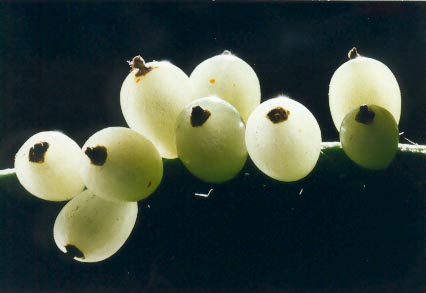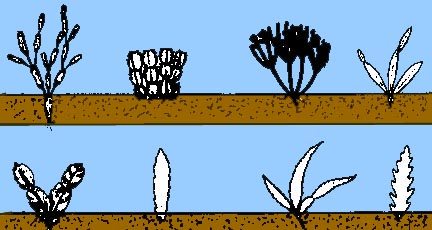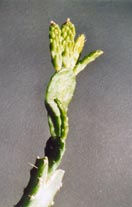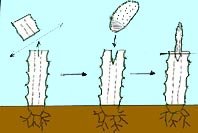

PROPAGATION OF EPIPHYTIC CACTI
********
RHIPSALIS BACCIFERA FRUIT
The three main modes of propagation that can be used are the following : sowing, cutting and grafting.
SOWING
It's a particularly attractive mode of propagation. It's fascinating
to observe the seeds’ germination and seedlings’ growth. But this
process has also many disadvantages. First of all, it is not appropriate for
hybrids because the blooming of the plants born by sowing will not be identical
to the one of the plant on which the seeds were collected. The process applies
to botanical species only as long as no unintentional hybridization occurred.
One can collect one’s own seeds even from one’s own collection.
But, to increase the range of the species owned, one has to use other collectors’
seeds or to buy seeds from specialized producers. European producers of cacti
seeds offer only very little choice of epiphytic ones (up to ten different kinds
at the most for all main catalogues). One can also try to get seeds on lists
of cacti collectors' associations. As for US producers, the CITES, phytosanitary,
customs and payment regulations discouraged many producers and customers. Moreover
it is necessary to wait for approximately five to six years at least between
sowing and observing the first blooms.
PROPAGATION BY CUTTINGS

It is undeniably the process best adapted to propagating epiphytic cacti. The method applies both to the botanical species as to hybrids since the propagation by cuttings is cloning. The same supplying regulations are applied (even more srictly than for seeds unfortunately) as far as US producers are concerned (many even stopped exports of cuttings outside the United States altogether). So, it's better (for Europe, anyway) to buy in Europe only (France, The United Kingdom, the Netherlands, Belgium, Germany, Italy), (see list of main European producers on the links page of my site). This way, you can have a wide enough choice ; it's also possible to exchange or purchase cuttings from other cacti collectors.
The epiphytic cacti propagation by cuttings is undoubtedly a quite easy method
enabling sometimes to enjoy blooms the very first year right after making the
cutting. It's possible to take cuttings all year long, although it's easier
in spring and in summer. Cuttings can be taken between two segments or a little
bit below the stems ramifications : stems separations or stems
ramification points are the spots where roots form most easily. (see illustration
above). Before setting the cuttings in the same compost as adult plants, one
must wait one week at least, leaving the cuttings in a dry place so that they
can heal from the cut.
After being planted in small plastic pots, the cuttings need constant heat and
humidity to form their roots; thus it is necessary to frequently sprinkle and
spray them to maintain the soil permanently slightly wet. If the cuttings are
made in winter, then they must be kept inside at an approximate temperature
of 20°C, heating the ground if necessary thanks to a small electric resistance.
In winter I supply the cuttings with light, therefore using a horticultural
neon tube. The artificial lighting duration varies at least from ten to twelve
hours per day. Thus summer is simulated and the cuttings root and grow more
easily. From time to time I do not hesitate to add a liquid fertilizer when
watering my cuttings.I repot the cuttings one to two years after the propagation.
GRAFTING
 graft of Schlumbergera opuntioides on Selenicereus
graft of Schlumbergera opuntioides on Selenicereus 
Grafting is about a method particularly suitable for difficult species or for producers who want to gain time. It is a somehow fascinating process and it works very well but I will not elaborate on this subject because I only rarely practise this method. The grafted plants generally grow more quickly than cuttings on their own roots but I find them more delicate and unattractive. Some people will say exactly the contrary, one must try to decide. The usual stocks are Selenicereus or some Rhipsalis which have a thick stem like Rhipsalis paradoxa.
Grafting must be made in beautiful dry weather to facilitate healing. One uses
a rootstock in vegetative activity, watered and put in a warm location one ore
two weeks before grafting. Depending on cases, grafting can be a flat or a cleft
grafting. In both cases it is necessary to put in contact the stock vessels
with the scion. Just after grafting,the stock and the scion must be maintained
in close contact either by using a rubber band (for flat grafting) or using
a cactus spine (for cleft grafting). The stock and scion set will be kept in
vegetative activity during the weeks which follow grafting.
RESCUE OF A PLANT WHICH BEGINS TO ROT
I often saved a plant whose neck has started rotting by using the following method : I cut the plant above the rotted part and I make sure that the remaining part is not contaminated, observing the color of the vessels which must be free of any brown or reddish colour traces; I cover the cut with charcoal powder and I let it dry for some days. Then I make a cutting with the remaining part ; I put it in pure sand which I keep in a warm and humid location for a few weeks. Pure sand is a culture medium particularly favourable to the formation and the development of new roots. Then, after one or two months, I put the rooted plants in a normal soil.
ADULT PLANTS PURCHASE
Basically this isn't propagation, but, it’s an excellent way to start or to increase an epiphytic cacti collection, and it's also possible to buy adult plants from the specialized producers.